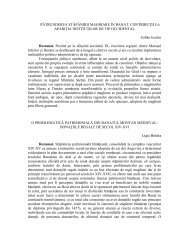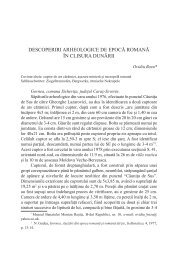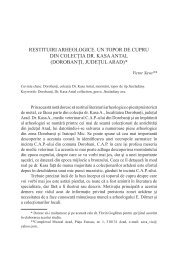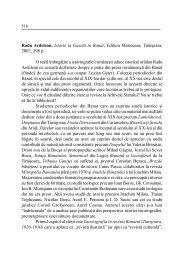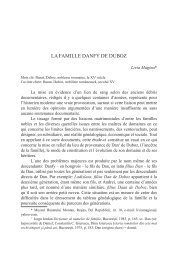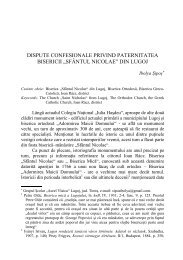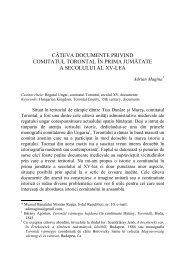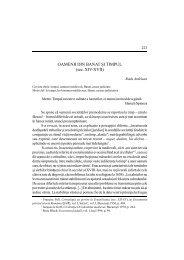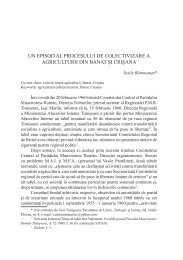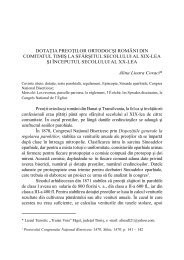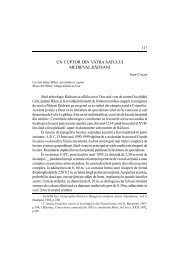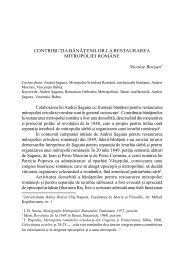Alexandru Simon - Banatica
Alexandru Simon - Banatica
Alexandru Simon - Banatica
You also want an ePaper? Increase the reach of your titles
YUMPU automatically turns print PDFs into web optimized ePapers that Google loves.
main Hungarian rival, to divide his attention, as the former had become more<br />
and more involved in south-Carpathian politics prior even to his appointment<br />
as voivode of Transylvania in 1510. Except for the ‘Habsburg profits’, Bogdan<br />
III’s Walachian actions brought however little gain. After Buda had abandoned<br />
him (she did not want to antagonize the local elite), Mihnea had won the throne<br />
with Ottoman support. Then he crossed over to his former protectors. This<br />
costed him his throne and his life (1508-1510). The Ottomans did not take<br />
direct action against Moldavia and were content to replace Mihnea with Vlad<br />
V. Vlad V too lost his life, but not because he chose the ‘Christian side’, but<br />
because he broke his loyalty to Bayezid during the Ottoman civil and sided, like<br />
several Walachian boyars, and in particular Bogdan, with the sultan’s challenger<br />
and son, Selim I. Although the new imperial crisis exceeded even the Djem<br />
crisis in Ottoman importance, no major Christian plan was drafted in order to<br />
bring the empire to at least its European fall, not even by Maximilian I of<br />
Habsburg. In 1508, he had crowned himself emperor without a Romzug, which<br />
he had claimed, for more than a decade, to be just the start of his great<br />
Türkenzug 6 .<br />
II. Crusader Thoughts and Türkenpraktiken during the Ottoman Civil<br />
War of 1510-1512<br />
The Ottoman civil war completed the Muslim turmoil. Since 1504, the<br />
Muslim world was at war. The former adversaries, the Ottoman Empire and<br />
6 For the context: F. Babinger, Kaiser Maximilians I. Geheime Praktiken mit den Osmanen<br />
(1510/ 1511), in Südost-Forschungen. Internationale Zeitschrift für Geschichte, Kultur und<br />
Landeskunde Südosteuropas, XV, 1956, p. 201-236; A. Kubinyi, The Road to Defeat: Hungarian<br />
Politics and Defense in the Jagiellonian Period, in From Hunyadi to Rákóczi: War and<br />
Society in Later Medieval and Early Modern Hungary, edited by János M. Bak, Béla K. Király,<br />
New York-Boulder, 1982, p. 159-178 (p. 161-165); Hans [Peter-Alexander] Theunissen, Ottoman-Venetian<br />
Diplomatics: The Ahdnames. The Historical Background and the Development<br />
of a Category of Political Commercial Instruments, in Electronic Journal of Oriental Studies,<br />
I 1998, 2, p. 3-586 (p. 148-152); Martin C. Rady, Rethinking Jagiello Hungary 1490-1526, in<br />
Central Europe, London, III, 2005, 1, p. 3-18 (especially p. 10-12); Ştefan Andreescu, Marea<br />
Neagră în lupta pentru succesiunea la tronul otoman din anii 1510-1512, in SMIM, XXV,<br />
2007, p. 29-46. For Ottoman-Christian comparative perspectives (1480s and 1510s), see also<br />
Colin Imber, The Ottoman Empire. 1300-1650. The Structure of Power, New York, 2002, p. 43-<br />
44; Al. <strong>Simon</strong>, Lumea lui Djem. Suceava, Buda şi Istanbul în anii 1480, in AIIA Cluj, 2005, p.<br />
11-43 (here p. 38-42).<br />
61



